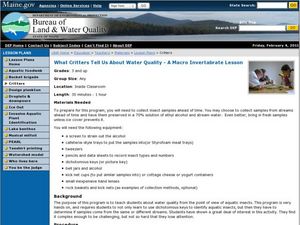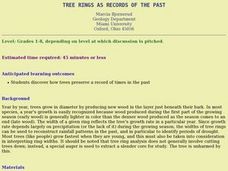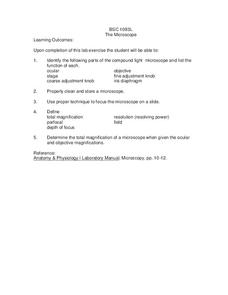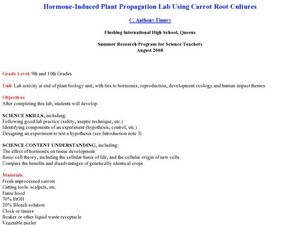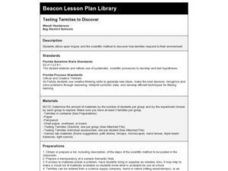Curated OER
Worming Your Way Through the Soil
Students study soil, living and non-living particles in the soil, and learn about composting. In this soil study lesson, students study soil samples and discuss the living and non-living components of the soil. Students classify the...
Curated OER
What Does It Eat?
Young scholars use crickets, mealworms, and pill bugs and observe what they choose to eat. In this science lesson plan, students record data, create graphs, and do a write up on what they see happening.
Curated OER
Charting Mold Growth
Students chart mold growth based on food supply. In this mold growth lesson plan, students chart micro-organism growth and the decline of the growth as food runs out.
Curated OER
A Tree is an Ecosystem
Students make observations about trees. In this ecosystem lesson, students observe and record all living and non living things they find under a tree, look for birds nests, evidence of woodpeckers and take samples such as leafs, bark,...
Curated OER
What Critters Tell Us About Water Quality: A Macroinvertebrate Lesson
Students explore our ecosystem by investigating the quality of our water. In this aquatic insect lesson, students examine a group of random insects collected from different streams and ponds in the area. Students record their...
Curated OER
Introduction to Biology
Young scholars examine a microscope and learn its functions. In this microscope lesson students prepare a wet mount slide and complete calculations.
Curated OER
Applied Science-Science and Math Lab
Learners explore magnification. In this scientific observation skills lesson, students observe sea life items and draw pictures of what they observe. Learners predict which lens will have the strongest magnification when given three...
Curated OER
Science of Money
Students observe oxidation reaction in the lab using copper pennies. For this chemistry lesson, students examine a $1 dollar bill and record their observations. They explain how to identify counterfeit money using the iodine test.
Curated OER
Life in a Log
Students identify insects living in rotting logs. In this decomposition instructional activity, students observe pieces of a rotting log, they look at the insects that have inhabited the log and create a chart that shows their findings.
Curated OER
What Parts Are There to a Plant?
Learners explore botany by completing plant science worksheets. In this plant anatomy instructional activity, students examine real vegetables in class using magnifying glasses. Learners identify the plants anatomy and complete...
Curated OER
Microscopes and Telescopes
Young scholars analyze a microscope and study what they do. In this investigative lesson students study how microscopes were first invented, and how ray diagrams are used in conjunction.
Curated OER
Pinhole Viewer
Students make a pinhole viewer to demonstrate how it inverts light passing through it which produces inverted images.
Curated OER
Tree Rings As Records of the Past
Students discover how trees preserve a record of times in the past.
Curated OER
This Rock is Your Rock, This Rock is My Rock
Students develop good observational skills. They examine how rocks are made up of one or more minerals.
Curated OER
This is Your Rock, This is My Rock
Fourth graders review the types of rocks and minerals they see in photographs. Individually, they are shown a sample of rocks or minerals and classify them based on their characteristics. They give their observations to another...
Curated OER
The Microscope
For this microscope lesson students explore the compound light microscope. Students discover techniques concerning cleaning, storage and proper use of the microscope. Students discover the working parts of the compound light microscope...
Curated OER
Hormone-Induced Plant Propagation Lab using Carrot Root Cultures
Learners evaluate the importance of hormones in living things. In this biology lesson, students experiment on carrots to differentiate how humans and plants reproduce. They collect data from experiment to answer analysis questions.
Curated OER
Mineral Lab
Eighth graders examine the physical properties of different minerals. For this earth science lesson, 8th graders explain the uses of minerals in their daily lives. They complete the mineral identification table during the lesson.
Curated OER
Eye Safety
Tenth graders become aware of the need for eye safety in the classroom through three mini labs.
Curated OER
Physical Properties Of Coal
Learners examine and identify the observable properties of coal. After a lecture/demo, students perform a simple experiment. They observe samples of coal and record data in an organized manner.
Curated OER
Tree Anatomy
Students learn the basic anatomy of a tree through exploration of tree centers.
Curated OER
Testing Termites to Discover
Students design an experiment to discover how termites respond to their environment.
Curated OER
Cloud Shadows
Students classify the visual opacity of various materials, what is needed to create shadows, and classify clouds by the types of shadows that they produce.
Curated OER
Does a change in pH affect the growth and survival rate of aquatic plants?
Students determine if changes in pH affect the growth and survival rates of aquatic plants. They evaluate the optimal pH levels for the growth of aquatic plants.
Other popular searches
- Lenses & Slides
- Convex and Concave Lenses
- Lenses and Microscopes
- Concave Lenses
- Concave & Convex Lenses
- Magnifying Lenses
- Convex Lenses
- Converging Lenses
- Lenses & Optics
- Mirrors and Lenses
- Hand Lenses and Microscopes
- Ray Diagrams Light Lenses






